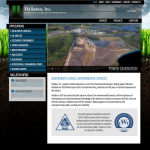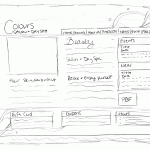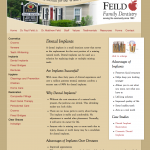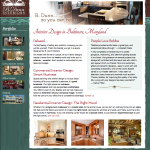5 things analytics teach you and what to do about them.
If you have a website, you have probably wondered how many people have visited your site, where they are coming from, and what pages are most popular. How do you find out? The answer is analytics. This article tells you what kind of information is available to you and what strategic marketing decisions you can make as a result. Click the graphics to enlarge.
1. Hits: Is this place popular?
Analytics tell you how many visitors came to your website, how many pages they visited, and how long they stayed on the site.
By themselves, these numbers are just useful for stroking your ego, but in comparison to other numbers, they can have strategic value.
What to do:
- Look for patterns over time. Growing popularity of a site can indicate success in other marketing efforts like a newsletter, networking, and linking from other sites.
- Look for relative popularity among websites. Knowing which of your websites is getting more visitors can help you determine your content strategy. Which sites need which kind of content? How can you leverage the popularity of one site to benefit another (generate some referral traffic)?
2. Demographics: Where are y’all from?
Demographics data reveal how much web traffic comes from where. This data can be analyzed by country, region, and city.
What to do:
- Look for places with lots of visitors. Ask if there is any strategic advantage to catering more to this geographic area. Could you develop content specifically for this area?
- Does popularity in an area indicate demand for more of a presence there? How can you best serve this expressed desire for the value your business brings?
Beware of false conclusions: One client recently noted a large amount of traffic coming from a distant state. This led to a discussion about catering more to this market until we discovered that the traffic was coming from visitors searching for a company with a similar name in that region. Before jumping to conclusions, check this data against other analytic measurements.
3. Content: So what’s good here?
Analytics tell you which pages are getting the most user attention. Most business owners are surprised how few pages get most of the traffic. In a recent sampling of our customers, we found that on a typical site about 50% of the traffic was generated by just 4–5 pages.
Knowing which pages are popular can also shape your content strategy. In a recent sampling of our customer websites, we discovered that certain types of pages are more popular than others. This chart shows that beyond the home page, most users want information about the people behind the company. This is good to know when you are deciding what content to develop and how prominently to feature certain navigation elements.
The Hidden Team
Recently a client told us they didn’t really want a page for the people at the company. They only had a few staff members, and they reasoned that revealing this would give the impression that they had very limited capacity. After discovering that users cared a lot about the people, they changed their strategy and included other ways of showing capacity, including linking to partners and affiliates.
What to do:
- A popular section of your website indicates user interest. Make sure your content actually answers user questions. Explore what other information you can provide them. And make a clear path from these pages to the desired action step.
4. Goals: Paving the desired path
Every web visit is a journey through the content. Some people just visit one page and leave (this is called a “bounce”). Others visit many pages before exiting, even spending a long time absorbing the material. And not everyone enters the site on the home page—many come to an interior page from a search engine link.
But the visit that pays the bills is the one that results in users taking a desired action step (called a “goal”).
What to do:
- Create Goals
: Setup clear goals for your website. Examples include signing up for an email series, ordering a product, downloading a free sample, etc.
- Develop Content:
Create words and graphics that make the goal look like the obvious path to take.
- Measure Results
: Check analytics to find out how many users are reaching the goal.
- Refine the Process
: Test changes to the content to improve the success rate.
5. Technology: What’s everyone using these days?
Analytics provide a boat-load of data on user technology, including operating system, browser, screen resolution, service provider, and so on. This information can be helpful when deciding what technology to employ in your website.
Beware: Business Owner Bias
It’s common for business owners to want their website to look good on the devices they use themselves. IT folks often report getting a request to support a burgeoning technology or device as soon as the CEO gets a new toy. But just because the CEO has a device doesn’t mean that most users do. Analytics can neutralize the bias and help the team focus on what users are actually using.
What to do:
- Notice trends in user behavior and anticipate what the users will want in the near future. Then optimize the site for them. In the last few years, the biggest trend we’ve seen is the rise of smart phones and tablets (primarily the iPad). We anticipate that these devices will soon be more popular for browsing the web than person computers—in fact in some markets they already are.
- If your website doesn’t look good or work well on a popular platform then you might be shutting down that segment of the market from easily growing your business. Fix this by hiring someone to make your website work well on every device that’s important to users.
More Help with Analytics
These are just the first steps in using analytics. If this interests you, contact us to help you grow your business.

































